782. Neergaard's Sunbird Cinnyris neergaardi (Bloukruissuikerbekkie)
Order: Passeriformes. Family: Nectariniidae
Description
Lentgh 11 cm, mass 6 g. A small sunbird with short, decurved bill. Green and black with scarlet band on the lower chest fringed blue on the upperside. Blue rump.
Breeding male: (It is not known if the male has an eclipse plumage) Upperparts iridescent green, except for the upper tail coverts (iridescent blue) and the tail, flight feathers and greater wing coverts (blackish). The neck, throat and upper breast are also iridescent green, and it has yellow pectoral tufts. A narrow, iridescent violet-blue breast band separates the green upper breast from a broad crimson-red breast band. The belly is blackish and the bill is short and slightly decurved.
Female: The upperparts are grey-brown, and the eyebrow is whitish. The tail, flight feathers and greater wing coverts are darker. The underparts are plain grey-buff, with the central belly being yellowish.
Similar species: The Purple-banded Sunbird is similar, but the male has a purple breast-band and does not have yellow pectoral tufts. The female Purple-banded Sunbird has a streaked breast.
Distribution
Restricted to Northern KwaZulu-Natal and Eastern Mozambique. Uncommon in south-eastern Mozambique, with a localised population in the far south of the country marginally extending into KwaZulu-Natal. Neergaard’s Sunbird is endemic to the east coast littoral, extending continuously from just south of Richards Bay northwards to Inhambane in Mozambique. It is usually found in fairly dense dry vegetation, notably the sand forest of Mkuze, False Bay, Ndumu and Tembe nature reserves.
Habitat
Sand forest and thornveld. In inland areas it generally prefers mixed, Acacia and the undergrowth of miombo (Brachystegia) woodland along streams, while its southernmost population is most common in coastal sand forest.
Diet
It mainly feeds on the nectar of trees, creepers, epiphytes and mistletoes but in summer, when nectar is scarce, it may supplement its diet with arthropods and juice sucked from fruit.
Breeding
Monogamous. The nest is built by the female, consisting of an oval-shaped structure with a side entrance concealed by a hanging flap of material. In sand forest it is often built of old-man's-beard lichen (Usnea) and lined with seed pods of Spider flower poison-rope (Stropanthus gerrardii), but in other areas it can be made of tendrils, bark and leaves bound with spider web. It is typically placed in a tree about 4-6 metres above ground, often concealed by a dense clump of old-man's beard lichen or the hanging roots of an orchid. It lays about 2 creamy white eggs speckled with brown, grey and mauve, usually in the period from September-January. The chicks are fed by both parents but mainly the female, on a diet of insects, spiders and arboreal snails.
Call
High-pitched ti-ti-ti-ti.
Status
Locally common resident in suitable habitat, but range restricted. Near-threatened largely due to forest destruction, which has caused its range to contract; it at least has a few reasonably sized populations in protected areas.
Africa Wild Bird Book
Neergaard's Sunbird
Dewi
What is the good of having a nice house without a decent planet to put it on? (H D Thoreau)
What is the good of having a nice house without a decent planet to put it on? (H D Thoreau)
Neergaard's Sunbird Photos
782. Neergaard's Sunbird Cinnyris neergaardi (Bloukruissuikerbekkie)
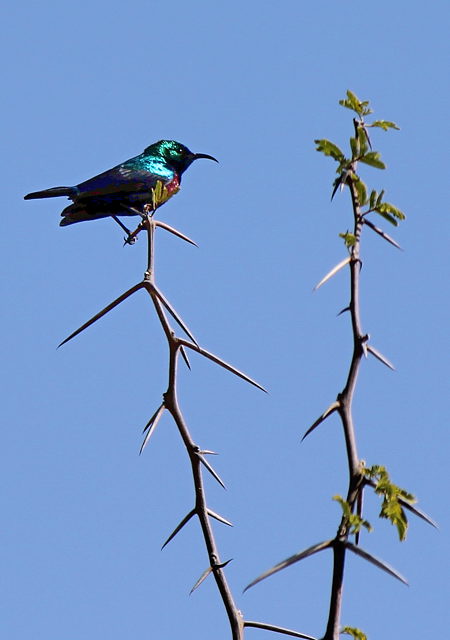
Male
Links:
Species text in The Atlas of Southern African Birds
Sabap2

Male
Links:
Species text in The Atlas of Southern African Birds
Sabap2
Dewi
What is the good of having a nice house without a decent planet to put it on? (H D Thoreau)
What is the good of having a nice house without a decent planet to put it on? (H D Thoreau)
Greater Double-collared Sunbird
785. Greater Double-collared Sunbird Cinnyris afer (Groot-rooibandsuikerbekkie)
Order: Passeriformes. Family: Nectariniidae
Description
Size 14-15 cm, weight 11 g. The male Greater Double-collared Sunbird has a brilliant red band across the chest. As with other sunbirds the bill is long and decurved. The bill of this species is longer and more curved than that of the Southern Double-collared Sunbird. The bill, legs and feet are black. The eye is dark brown.
The male has a brilliant glossy, metallic green head, throat upper breast and back. A narrow metallic blue band separates the green of the upper breast from the wide red breast band, below which the breast and belly are smoky-grey. The rump is blue When displaying bright yellow pectoral tufts can be seen on the shoulders. The male can be distinguished from the similar Southern Double-collared Sunbird by the latter’s smaller size, narrower red chest band and shorter bill.
The female is brownish grey above with yellowish-grey underparts.
Distribution
Endemic to South Africa and Swaziland, occurring in a band from the Limpopo Province through Mpumalanga and Swaziland to KwaZulu-Natal, down the coast to the Western and Eastern Cape.

Habitat
It generally prefers edges of Afromontane, coastal and dune forest, dry valley bushveld, montane tall shrublands, woodland along water courses in arid regions, Acacia savanna, parks and gardens.
Diet
It eats nectar supplemented with arthropods and fruit, probing flowers with its bill to obtain nectar, sometimes sucking juice out of fruit. It also hawks insects aerially and gleans prey from leaves and twigs, often joining mixed species aggregations at large sources of nectar.
Breeding
The nest is built solely by the female in about 10-24 days, consisting of a an oval-shaped structure built of a variety of materials, such as dry grass, bark shreds, wool, cottony material, feathers, fur, leaves, lichen, rootlets, twiglets and string bound together with spider web. The entrance hole is positioned on the side, protected by a hood of grass (especially Panicum and Eragrostis) sticking out of the side of the nest. It usually decorates the exterior with large leaves, sloughed snake skin, paper and lichen, lining the inside with feathers and hair. It is typically placed 2-6 metres above ground in a tree with dense foliage. Egg-laying season is almost year-round, peaking from July-November. It lays 1-2, usually 2 oval eggs, which are incubated solely by the female for about 15-16 days. The chicks are fed by both parents, leaving the nest after about 15-16 days and becoming independent about 10 days later.
Call
The call is a hard chut-chut-chut, and the song is a high pitched jumble of tweets and twitters, richer than the calls of the Southern Double-collard Sunbird. Listen to Bird Call.
Status
Locally common resident.
Order: Passeriformes. Family: Nectariniidae
Description
Size 14-15 cm, weight 11 g. The male Greater Double-collared Sunbird has a brilliant red band across the chest. As with other sunbirds the bill is long and decurved. The bill of this species is longer and more curved than that of the Southern Double-collared Sunbird. The bill, legs and feet are black. The eye is dark brown.
The male has a brilliant glossy, metallic green head, throat upper breast and back. A narrow metallic blue band separates the green of the upper breast from the wide red breast band, below which the breast and belly are smoky-grey. The rump is blue When displaying bright yellow pectoral tufts can be seen on the shoulders. The male can be distinguished from the similar Southern Double-collared Sunbird by the latter’s smaller size, narrower red chest band and shorter bill.
The female is brownish grey above with yellowish-grey underparts.
Distribution
Endemic to South Africa and Swaziland, occurring in a band from the Limpopo Province through Mpumalanga and Swaziland to KwaZulu-Natal, down the coast to the Western and Eastern Cape.

Habitat
It generally prefers edges of Afromontane, coastal and dune forest, dry valley bushveld, montane tall shrublands, woodland along water courses in arid regions, Acacia savanna, parks and gardens.
Diet
It eats nectar supplemented with arthropods and fruit, probing flowers with its bill to obtain nectar, sometimes sucking juice out of fruit. It also hawks insects aerially and gleans prey from leaves and twigs, often joining mixed species aggregations at large sources of nectar.
Breeding
The nest is built solely by the female in about 10-24 days, consisting of a an oval-shaped structure built of a variety of materials, such as dry grass, bark shreds, wool, cottony material, feathers, fur, leaves, lichen, rootlets, twiglets and string bound together with spider web. The entrance hole is positioned on the side, protected by a hood of grass (especially Panicum and Eragrostis) sticking out of the side of the nest. It usually decorates the exterior with large leaves, sloughed snake skin, paper and lichen, lining the inside with feathers and hair. It is typically placed 2-6 metres above ground in a tree with dense foliage. Egg-laying season is almost year-round, peaking from July-November. It lays 1-2, usually 2 oval eggs, which are incubated solely by the female for about 15-16 days. The chicks are fed by both parents, leaving the nest after about 15-16 days and becoming independent about 10 days later.
Call
The call is a hard chut-chut-chut, and the song is a high pitched jumble of tweets and twitters, richer than the calls of the Southern Double-collard Sunbird. Listen to Bird Call.
Status
Locally common resident.
Greater Double-collared Sunbird Photos
785. Greater Double-collared Sunbird Cinnyris afer
Order: Passeriformes. Family: Nectariniidae
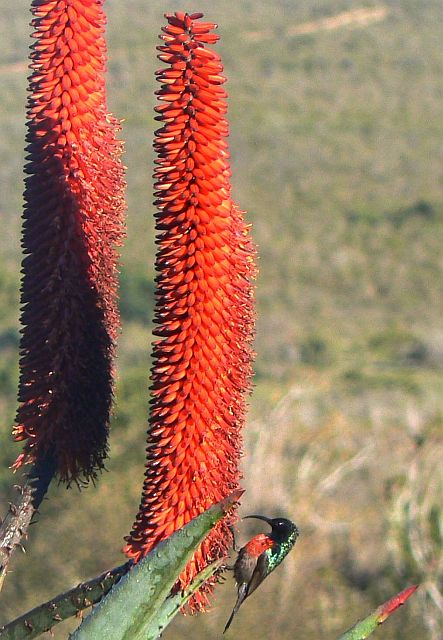 © nan
© nan
Male foraging
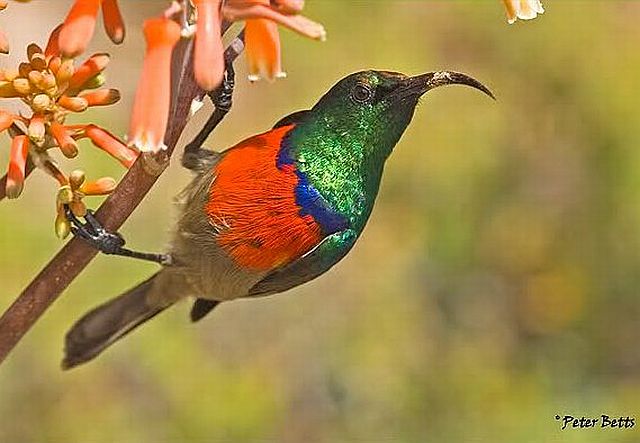 © Peter Betts
© Peter Betts
Male with pollen on bill
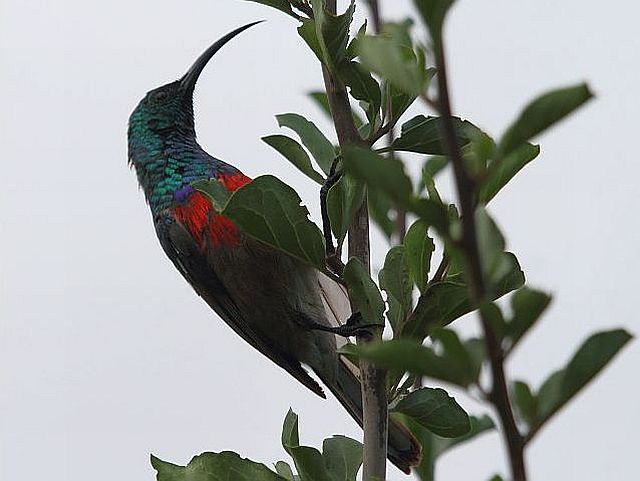 © Sharifa
© Sharifa
Addo Elephant National Park
 © Mel
© Mel
Female
 © okie
© okie
Juvenile
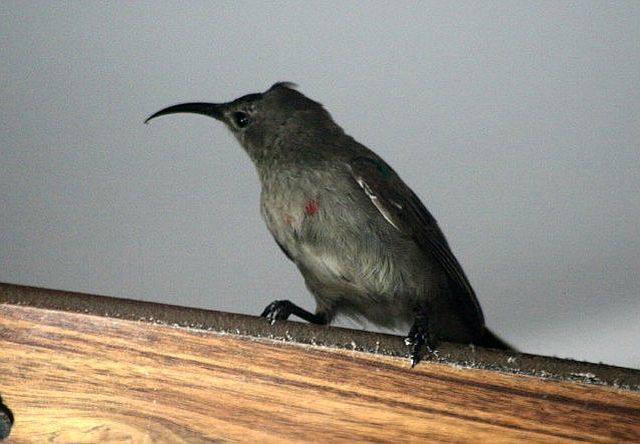 © okie
© okie
Juvenile
Links:
http://sabap2.adu.org.za/spp_summary.ph ... §ion=3
http://sabap2.adu.org.za/docs/sabap1/785.pdf
Roberts online
Order: Passeriformes. Family: Nectariniidae
 © nan
© nanMale foraging
 © Peter Betts
© Peter BettsMale with pollen on bill
 © Sharifa
© SharifaAddo Elephant National Park
 © Mel
© MelFemale
 © okie
© okieJuvenile
 © okie
© okieJuvenile
Links:
http://sabap2.adu.org.za/spp_summary.ph ... §ion=3
http://sabap2.adu.org.za/docs/sabap1/785.pdf
Roberts online
- nan
- Posts: 26476
- Joined: Thu May 31, 2012 9:41 pm
- Country: Switzerland
- Location: Central Europe
- Contact:
Marico Sunbird
779. Marico Sunbird Cinnyris mariquensis (Maricosuikerbekkie)
Order: Passeriformes. Family: Nectariniidae
Description
Size 11-13.5 cm. Upperside and throat green, belly and lower breast dark, and between these a narrow blue band near the throat and below a broad purple band. The bill is dark, decurved.
The female has grey-brown upperparts, narrow supercilium and yellow, heavily dusky-streaked underparts with paler throat. It may be distinguished from female Purple-banded Sunbird by its larger size and longer, thicker bill.
The juvenile resembles the female, but has a blackish throat and mottled breast.
Similar species: May be distinguished from the very similar Purple-banded Sunbird by its larger size, longer, thicker bill, and broader purple breast bank. It differs from the Greater Double-collared Sunbird and Southern Double-collared Sunbird by its black (not grey) belly and from the Shelley's and Neergaard's Sunbird by its purple (not red) breast band.
Distribution
It occupies two separate areas of sub-Saharan Africa; one population occurs from Eritrea to Tanzania while the other extends from Angola and south-western Zambia to southern Africa. Here it is locally common from Namibia (mainly central Namibia extending north to the Oshikato Region and the Caprivi Strip) through Botswana to Zimbabwe, southern Mozambique and northern and north-eastern South Africa.
Habitat: Thornveld and dry, broad-leaved woodland.
Diet
It feeds on nectar and arthropods, gleaning prey from foliage and hawking insects aerially.
Breeding
Monogamous. The nest is built solely by the female in about 6-12 days, consisting of a compact, pear-shaped structure built of dry grass reinforced with spider web, with a side-top entrance covered by a hood of grass stems. It is usually camouflaged using dark material, such as bark, lumps of resin, small flowers, plant seeds, caterpillar feces and seed capsules, thickly lining the interior with plant down or feathers to the point that the nest bulges or even splits. It is typically attached with spider web to an upright twig or branch in the dense foliage of a tree or bush, about 2-8 metres above ground. Egg-laying season is from July-February, peaking from about September-November. The female lays 1-3 eggs, which are incubated solely by the female for about 13-15 days. The chicks are fed solely by the female, but once they fledge both parents continue to feed them for weeks longer, still coming back to roost in the nest every night.
Occasionally parasitised by Klaas's Cuckoo.
Call
A long series of closely spaced tsip's; a fast, warbling song.
Listen to Bird Call: http://www.xeno-canto.org/species/Cinnyris-mariquensis
Status
Common resident.
Order: Passeriformes. Family: Nectariniidae
Description
Size 11-13.5 cm. Upperside and throat green, belly and lower breast dark, and between these a narrow blue band near the throat and below a broad purple band. The bill is dark, decurved.
The female has grey-brown upperparts, narrow supercilium and yellow, heavily dusky-streaked underparts with paler throat. It may be distinguished from female Purple-banded Sunbird by its larger size and longer, thicker bill.
The juvenile resembles the female, but has a blackish throat and mottled breast.
Similar species: May be distinguished from the very similar Purple-banded Sunbird by its larger size, longer, thicker bill, and broader purple breast bank. It differs from the Greater Double-collared Sunbird and Southern Double-collared Sunbird by its black (not grey) belly and from the Shelley's and Neergaard's Sunbird by its purple (not red) breast band.
Distribution
It occupies two separate areas of sub-Saharan Africa; one population occurs from Eritrea to Tanzania while the other extends from Angola and south-western Zambia to southern Africa. Here it is locally common from Namibia (mainly central Namibia extending north to the Oshikato Region and the Caprivi Strip) through Botswana to Zimbabwe, southern Mozambique and northern and north-eastern South Africa.
Habitat: Thornveld and dry, broad-leaved woodland.
Diet
It feeds on nectar and arthropods, gleaning prey from foliage and hawking insects aerially.
Breeding
Monogamous. The nest is built solely by the female in about 6-12 days, consisting of a compact, pear-shaped structure built of dry grass reinforced with spider web, with a side-top entrance covered by a hood of grass stems. It is usually camouflaged using dark material, such as bark, lumps of resin, small flowers, plant seeds, caterpillar feces and seed capsules, thickly lining the interior with plant down or feathers to the point that the nest bulges or even splits. It is typically attached with spider web to an upright twig or branch in the dense foliage of a tree or bush, about 2-8 metres above ground. Egg-laying season is from July-February, peaking from about September-November. The female lays 1-3 eggs, which are incubated solely by the female for about 13-15 days. The chicks are fed solely by the female, but once they fledge both parents continue to feed them for weeks longer, still coming back to roost in the nest every night.
Occasionally parasitised by Klaas's Cuckoo.
Call
A long series of closely spaced tsip's; a fast, warbling song.
Listen to Bird Call: http://www.xeno-canto.org/species/Cinnyris-mariquensis
Status
Common resident.
Kgalagadi lover… for ever
https://safrounet.piwigo.com/
https://safrounet.piwigo.com/
- nan
- Posts: 26476
- Joined: Thu May 31, 2012 9:41 pm
- Country: Switzerland
- Location: Central Europe
- Contact:
Marico Sunbird Photos
779. Marico Sunbird Cinnyris mariquensis (Maricosuikerbekkie)

Male

Male
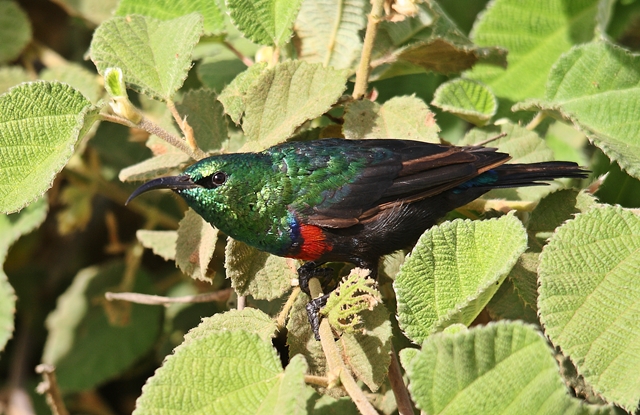 © Flutterby
© Flutterby
Male, Kruger National Park, Sunset dam
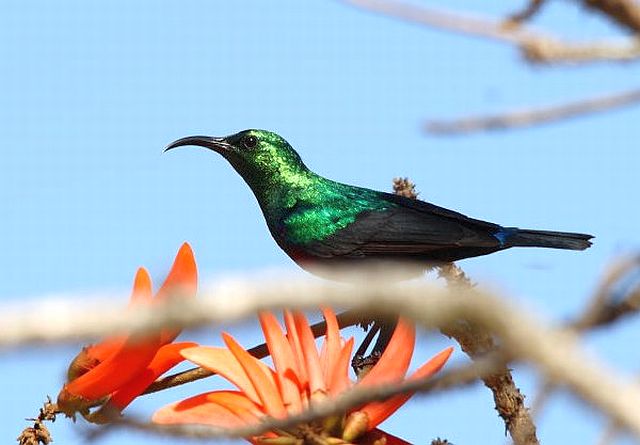 © Flutterby
© Flutterby
Male
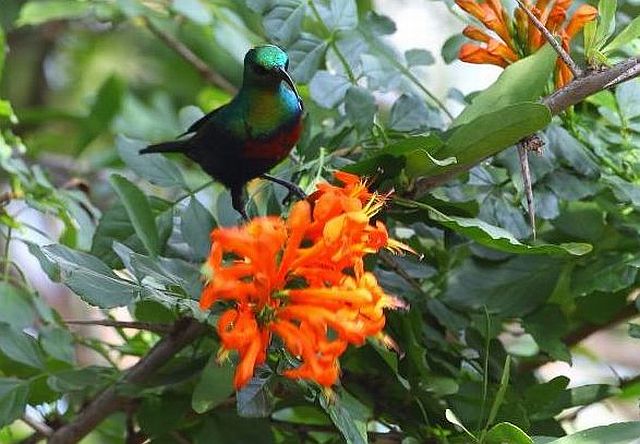 © Sharifa
© Sharifa
Male
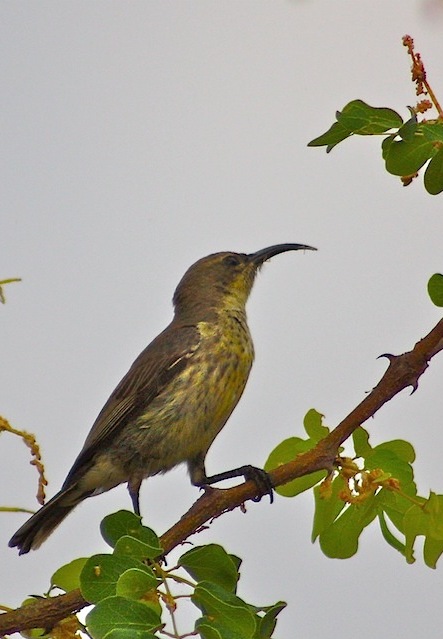 © ExFmem
© ExFmem
Female
 © ExFmem
© ExFmem
Female
Links:
Species text in The Atlas of Southern African Birds
Sabap2

Male

Male
 © Flutterby
© FlutterbyMale, Kruger National Park, Sunset dam
 © Flutterby
© FlutterbyMale
 © Sharifa
© SharifaMale
 © ExFmem
© ExFmemFemale
 © ExFmem
© ExFmemFemale
Links:
Species text in The Atlas of Southern African Birds
Sabap2
Kgalagadi lover… for ever
https://safrounet.piwigo.com/
https://safrounet.piwigo.com/
- Flutterby
- Posts: 44029
- Joined: Sat May 19, 2012 12:28 pm
- Country: South Africa
- Location: Gauteng, South Africa
- Contact:
Purple-banded Sunbird
780. Purple-banded Sunbird Cinnyris bifasciatus (Purperbandsuikerbekkie)
Order: Passeriformes. Family: Nectariniidae
Description
Length 11 cm. Iris dark brown; bill, legs and feet black.
Adult breeding male: Head, breast and upperparts are mostly irridescent green, washed bronzy on head, peacock blue on rump; the upper tail coverts are irridescent blue. The tail is blackish brown and the flight feathers are blackish. The throat and the upper breast are iridescent green, separated from a 10-12 mm wide purple breast band by a narrower irridescent dark blue band. The belly is black. The bill is fairly short, and is curved along its entire length.
Non-breeding male: Similar to female, but wings and tail black; rump metallic blue-green.
Adult female: The head and upperparts are olive, the tail is blackish, edged and tipped whitish. The flight feathers dark brown. The throat is dull yellow streaked brown, and the breast and belly are buff with diffuse streaking.
Similar Species: The Marico Sunbird is larger, and has a longer bill. The Purple-banded Sunbird has a smaller, thinner, less decurved bill.
Taxonomy
This is one of the many Sunbirds that have recently been moved to the genus Cinnyris from the genus Nectarinia.
Cinnyris bifasciatus has three subspecies which differ in the shade of the colour of their plumage, the width of the breast band, and bill length:
Cinnyris bifasciatus bifasciatus from Gabon, Congo, Democratic Republic of Congo, Angola, Kenya, Uganda, Rwanda, Tanzania, Mozambique, Malawi, Namibia, Botswana, South Africa, and Swaziland;
Cinnyris bifasciatus microrhynchus from Somalia, Kenya, and Tanzania
Cinnyris bifasciatus strophium from Uganda, Tanzania, Zambia, Zimbabwe, and South Africa.
Distribution
Occurs in localised patches from southern Somalia through to Uganda, southern DRC, Zambia, Angola, Malawi and southern Africa. Here it is locally common from Mozambique to KwaZulu-Natal, but scarce further west in Zimbabwe, northern Botswana and the Caprivi Strip, Namibia.
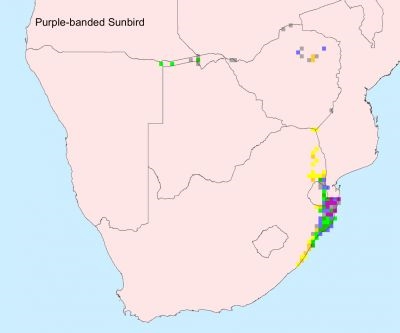
Habitat
It generally prefers coastal bush habitats, such as mangroves and edges of lowland evergreen forest, further inland occupying riverine forest, thickets and occasionally well-wooded gardens.
Diet
It mainly feeds on nectar (especially of mistletoes, Syzigium cordatum and Mimusops caffra) supplemented with small arthropods, doing most of its foraging in the heat of the day, when the flowers are open. They are found singly or in pairs, except when birds (up to several hundred in some cases) aggregate at good nectar sources. These Sunbirds move restlessly between food sources, males constantly chasing both females and other males of their own species.
Breeding
The nest is built solely by the female, consisting of a tidy, pear-shaped oval with a side entrance, built mainly of petioles and lichen bound with spider web, sometimes along with dry grass, plant fibres, leaves and fronds. A long tail of material hangs from the base of the structure, which is decorated with wood chips, lichen, caterpillar droppings and seeds, while the interior is lined with vegetable down and feathers. It is typically attached at the roof to a twig, creeper, small branch or bamboo, often overlooking water, a dry riverbed or roadway. Egg-laying season is from August to March, peaking from September to October. It lays 1-2, rarely 3 eggs, which are incubated solely by the female. Eggs are grey, white or buff, spotted, streaked and smeared with grey, purplish brown and black mainly at thick end. The chicks are fed by both parents.
Call
Characteristic 4-syllabled callnote tsikit-y-dik, not repeated in succession; song high-pitched short phrase of deliberate introductory notes, followed by somewhat variable trill, tsip tsip tsip tsip tsippity tsirrily tsirrily, tseep, with pauses between each phrase, not sustained as in Marico Sunbird; also trilling buzz brrrz.
Status
Locally common resident; some nomadic movements; vagrant to Southern Kruger National Park and to Durban.
Order: Passeriformes. Family: Nectariniidae
Description
Length 11 cm. Iris dark brown; bill, legs and feet black.
Adult breeding male: Head, breast and upperparts are mostly irridescent green, washed bronzy on head, peacock blue on rump; the upper tail coverts are irridescent blue. The tail is blackish brown and the flight feathers are blackish. The throat and the upper breast are iridescent green, separated from a 10-12 mm wide purple breast band by a narrower irridescent dark blue band. The belly is black. The bill is fairly short, and is curved along its entire length.
Non-breeding male: Similar to female, but wings and tail black; rump metallic blue-green.
Adult female: The head and upperparts are olive, the tail is blackish, edged and tipped whitish. The flight feathers dark brown. The throat is dull yellow streaked brown, and the breast and belly are buff with diffuse streaking.
Similar Species: The Marico Sunbird is larger, and has a longer bill. The Purple-banded Sunbird has a smaller, thinner, less decurved bill.
Taxonomy
This is one of the many Sunbirds that have recently been moved to the genus Cinnyris from the genus Nectarinia.
Cinnyris bifasciatus has three subspecies which differ in the shade of the colour of their plumage, the width of the breast band, and bill length:
Cinnyris bifasciatus bifasciatus from Gabon, Congo, Democratic Republic of Congo, Angola, Kenya, Uganda, Rwanda, Tanzania, Mozambique, Malawi, Namibia, Botswana, South Africa, and Swaziland;
Cinnyris bifasciatus microrhynchus from Somalia, Kenya, and Tanzania
Cinnyris bifasciatus strophium from Uganda, Tanzania, Zambia, Zimbabwe, and South Africa.
Distribution
Occurs in localised patches from southern Somalia through to Uganda, southern DRC, Zambia, Angola, Malawi and southern Africa. Here it is locally common from Mozambique to KwaZulu-Natal, but scarce further west in Zimbabwe, northern Botswana and the Caprivi Strip, Namibia.

Habitat
It generally prefers coastal bush habitats, such as mangroves and edges of lowland evergreen forest, further inland occupying riverine forest, thickets and occasionally well-wooded gardens.
Diet
It mainly feeds on nectar (especially of mistletoes, Syzigium cordatum and Mimusops caffra) supplemented with small arthropods, doing most of its foraging in the heat of the day, when the flowers are open. They are found singly or in pairs, except when birds (up to several hundred in some cases) aggregate at good nectar sources. These Sunbirds move restlessly between food sources, males constantly chasing both females and other males of their own species.
Breeding
The nest is built solely by the female, consisting of a tidy, pear-shaped oval with a side entrance, built mainly of petioles and lichen bound with spider web, sometimes along with dry grass, plant fibres, leaves and fronds. A long tail of material hangs from the base of the structure, which is decorated with wood chips, lichen, caterpillar droppings and seeds, while the interior is lined with vegetable down and feathers. It is typically attached at the roof to a twig, creeper, small branch or bamboo, often overlooking water, a dry riverbed or roadway. Egg-laying season is from August to March, peaking from September to October. It lays 1-2, rarely 3 eggs, which are incubated solely by the female. Eggs are grey, white or buff, spotted, streaked and smeared with grey, purplish brown and black mainly at thick end. The chicks are fed by both parents.
Call
Characteristic 4-syllabled callnote tsikit-y-dik, not repeated in succession; song high-pitched short phrase of deliberate introductory notes, followed by somewhat variable trill, tsip tsip tsip tsip tsippity tsirrily tsirrily, tseep, with pauses between each phrase, not sustained as in Marico Sunbird; also trilling buzz brrrz.
Status
Locally common resident; some nomadic movements; vagrant to Southern Kruger National Park and to Durban.
- Flutterby
- Posts: 44029
- Joined: Sat May 19, 2012 12:28 pm
- Country: South Africa
- Location: Gauteng, South Africa
- Contact:
Purple-banded Sunbird Photos
780. Purple-banded Sunbird Cinnyris bifasciatus
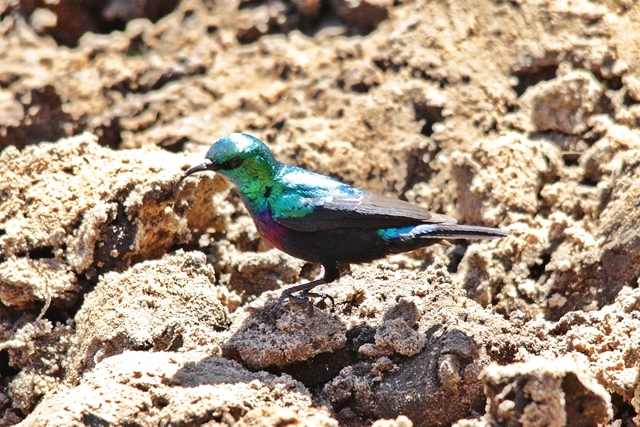 © Flutterby
© Flutterby
Male, uMkhuze Game Reserve, kuMasinga Hide
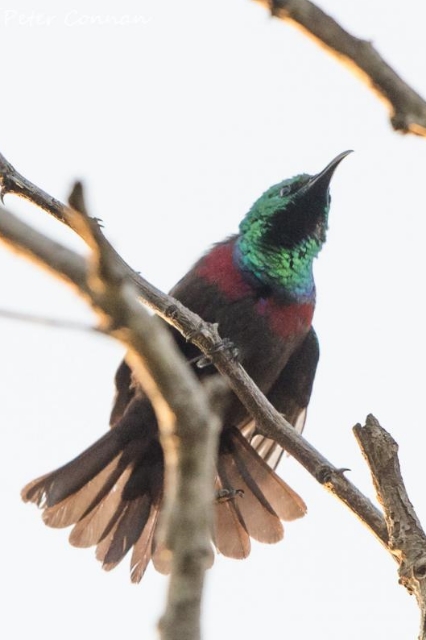 © Peter Connan
© Peter Connan
Male
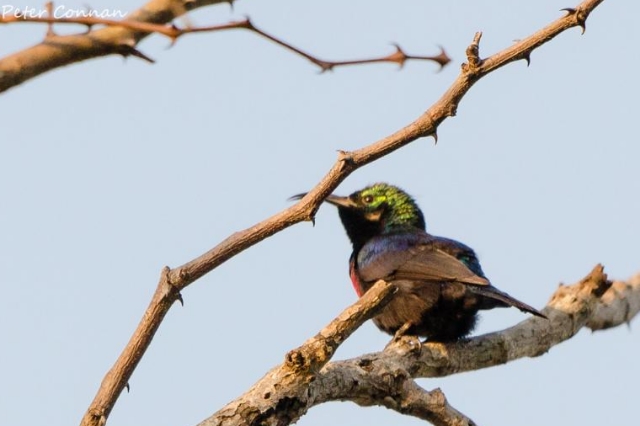 © Peter Connan
© Peter Connan
Phogolo, KwaZulu-Natal
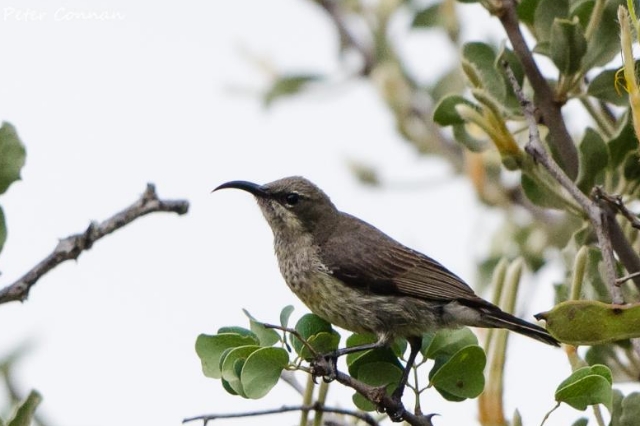 © Peter Connan
© Peter Connan
Female, Phogolo, KwaZulu-Natal
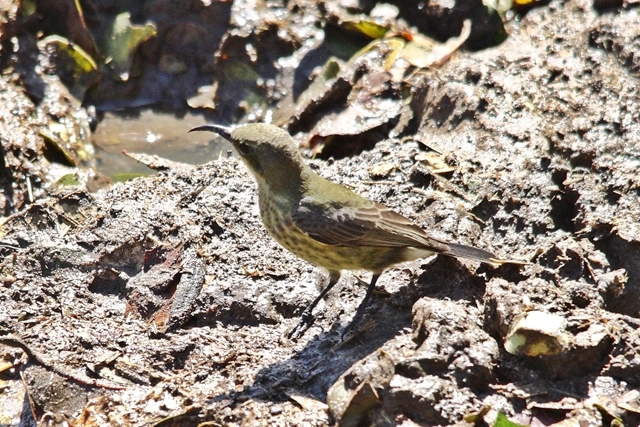 © Flutterby
© Flutterby
Female, uMkhuze Game Reserve, kuMasinga Hide
Links:
Sabap2
Clive F. Mann, Robert A. Cheke: Sunbirds: A Guide to the Sunbirds, Flowerpeckers, Spiderhunters
 © Flutterby
© FlutterbyMale, uMkhuze Game Reserve, kuMasinga Hide
 © Peter Connan
© Peter ConnanMale
 © Peter Connan
© Peter ConnanPhogolo, KwaZulu-Natal
 © Peter Connan
© Peter ConnanFemale, Phogolo, KwaZulu-Natal
 © Flutterby
© FlutterbyFemale, uMkhuze Game Reserve, kuMasinga Hide
Links:
Sabap2
Clive F. Mann, Robert A. Cheke: Sunbirds: A Guide to the Sunbirds, Flowerpeckers, Spiderhunters
Eastern Miombo Sunbird
784. Eastern Miombo Sunbird Cinnyris manoensis (Miombo-rooibandsuikerbekkie)
Order: Passeriformes. Family: Nectariniidae
Description
13cm; 9.5g
Apart from a narrower blue rump, the male is almost indistinguishable from the Southern Double-collared Sunbird. Separated from Shelley's Sunbird by blue (not green) rump and grey (not black) belly. Non-breeding male is similar to the female. The female is an overall drab-brownish grey, with yellowish mid-belly. Juvenile is like the female with strong yellow wash on underparts and yellow-orange gape.
The name changed from Miombo Double-collared Sunbird C. manoensis to Eastern Miombo Sunbird with split of Western Miombo Sunbird C. gertrudis.
Distribution
The Eastern Miombo Sunbird occurs from s Tanzania to se Zambia, Zimbabwe and n Mozambique, as well as on Mt. Gorongoza, Mozambique. It is common across much of Zimbabwe.
C. m. manoensis: c Tanzania to Zimbabwe and n Mozambique
C. m. amicorum: s Mozambique
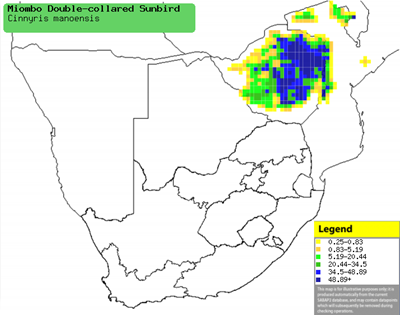
Habitat
Prefers miombo (Brachystegia) woodland but also occupying montane habitats, such as patches of pincushions (Leucospermum), Erica and Protea scrub, well wooded gardens and Acacia savanna (especially in winter when mistletoes are flowering).
Diet
It mainly eats nectar supplemented with arthropods, gleaning them from foliage and hawking prey aerially.
Breeding
The nest is built solely by the female in at least a week, consisting of a thick-walled oval-shaped structure made of forbs, shredded bark, dry leaves and fine grass, bound together with spider web. The entrance hole is positioned on the side, sometimes covered by a hood made of dry grass, while the interior is lined with feathers and plant down. It is typically suspended from a branch near a mass of spider webs, or occasionally beneath a house porch or building overhang. Egg-laying season is year-round, peaking from August-November. It lays 1-3 eggs, which are incubated solely by the female for approximately 14-16 days. The chicks are mainly fed by the female, leaving the nest after about 13-15 days, remaining dependent on their parents for at least one more week.
Call
High-pitched twittering.
Status
Common resident, locally nomadic. IUCN status - not threatened.
Order: Passeriformes. Family: Nectariniidae
Description
13cm; 9.5g
Apart from a narrower blue rump, the male is almost indistinguishable from the Southern Double-collared Sunbird. Separated from Shelley's Sunbird by blue (not green) rump and grey (not black) belly. Non-breeding male is similar to the female. The female is an overall drab-brownish grey, with yellowish mid-belly. Juvenile is like the female with strong yellow wash on underparts and yellow-orange gape.
The name changed from Miombo Double-collared Sunbird C. manoensis to Eastern Miombo Sunbird with split of Western Miombo Sunbird C. gertrudis.
Distribution
The Eastern Miombo Sunbird occurs from s Tanzania to se Zambia, Zimbabwe and n Mozambique, as well as on Mt. Gorongoza, Mozambique. It is common across much of Zimbabwe.
C. m. manoensis: c Tanzania to Zimbabwe and n Mozambique
C. m. amicorum: s Mozambique

Habitat
Prefers miombo (Brachystegia) woodland but also occupying montane habitats, such as patches of pincushions (Leucospermum), Erica and Protea scrub, well wooded gardens and Acacia savanna (especially in winter when mistletoes are flowering).
Diet
It mainly eats nectar supplemented with arthropods, gleaning them from foliage and hawking prey aerially.
Breeding
The nest is built solely by the female in at least a week, consisting of a thick-walled oval-shaped structure made of forbs, shredded bark, dry leaves and fine grass, bound together with spider web. The entrance hole is positioned on the side, sometimes covered by a hood made of dry grass, while the interior is lined with feathers and plant down. It is typically suspended from a branch near a mass of spider webs, or occasionally beneath a house porch or building overhang. Egg-laying season is year-round, peaking from August-November. It lays 1-3 eggs, which are incubated solely by the female for approximately 14-16 days. The chicks are mainly fed by the female, leaving the nest after about 13-15 days, remaining dependent on their parents for at least one more week.
Call
High-pitched twittering.
Status
Common resident, locally nomadic. IUCN status - not threatened.
- nan
- Posts: 26476
- Joined: Thu May 31, 2012 9:41 pm
- Country: Switzerland
- Location: Central Europe
- Contact:
Eastern Miombo Sunbird Photos
784. Eastern Miombo Sunbird Cinnyris manoensis
 © Dindingwe
© Dindingwe
Male, Harare, Zimbabwe
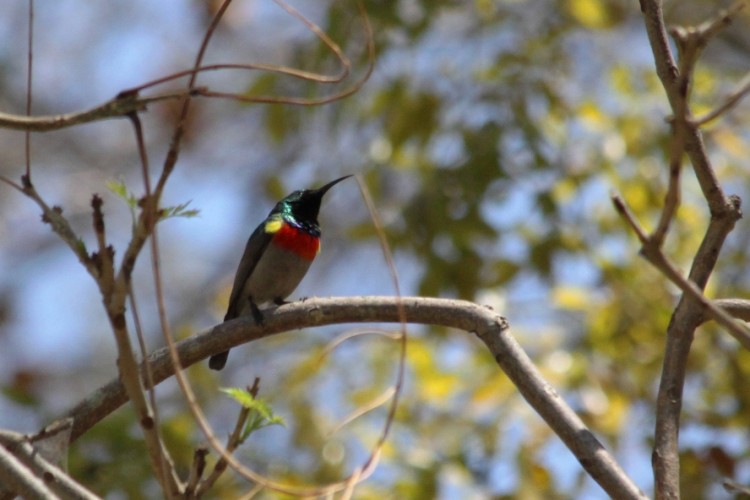 © Dindingwe
© Dindingwe
C. m. manoensis, Harare, Zimbabwe
Links:
http://www.biodiversityexplorer.org/bir ... oensis.htm
 © Dindingwe
© DindingweMale, Harare, Zimbabwe
 © Dindingwe
© DindingweC. m. manoensis, Harare, Zimbabwe
Links:
http://www.biodiversityexplorer.org/bir ... oensis.htm
Kgalagadi lover… for ever
https://safrounet.piwigo.com/
https://safrounet.piwigo.com/


